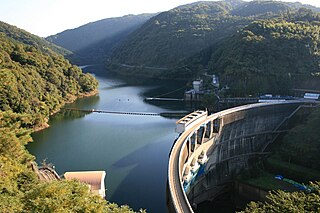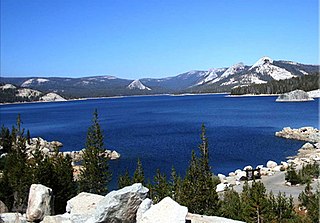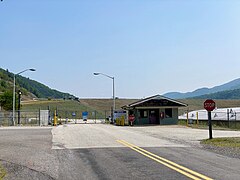
The Ludington Pumped Storage Plant is a hydroelectric plant and reservoir in Ludington, Michigan. It was built between 1969 and 1973 at a cost of $315 million and is owned jointly by Consumers Energy and DTE Energy and operated by Consumers Energy. At the time of its construction, it was the largest pumped storage hydroelectric facility in the world.

The Robert Moses Niagara Hydroelectric Power Station is a hydroelectric power station in Lewiston, New York, near Niagara Falls. Owned and operated by the New York Power Authority (NYPA), the plant diverts water from the Niagara River above Niagara Falls and returns the water into the lower portion of the river near Lake Ontario. It uses 13 generators at an installed capacity of 2,525 MW (3,386,000 hp) with an average annual net generation of 15,897,000 MWh between 2014 and 2023, and a capacity factor of 71.9%.

The Tokuyama Dam is an embankment dam near Ibigawa, Ibi District, Gifu Prefecture in Japan. The dam was completed in 2008 and will support a 153 MW hydroelectric power station that is expected to be fully operational in 2015. Currently, Unit 1 at 23 MW was commissioned in May 2014. The dam was originally intended to withhold the upper reservoir of a 400 MW pumped-storage power station until a design change in 2004. The dam is also intended for flood control and water supply. It is the largest dam by structural volume in Japan and withholds the country's largest reservoir by volume as well.
The Ingula Pumped Storage Scheme is a pumped-storage power station in the escarpment of the Little Drakensberg range straddling the border of the KwaZulu-Natal and Free State provinces, South Africa. It is about 22 km (14 mi) North-East of Van Reenen.

The Kannagawa Hydropower Plant (神流川発電所) is an under construction pumped-storage hydroelectric power plant near Minamiaiki in Nagano Prefecture and Ueno in Gunma Prefecture, Japan. The power plant utilizes the Minamiaiki River along with an upper and lower reservoir created by two dams, the upper Minamiaiki Dam and the lower Ueno Dam. The power station in between the two dams will contain six 470 megawatts (630,000 hp) pump-generators for a total installed capacity of 2,820 megawatts (3,780,000 hp). Unit 1 commenced commercial operation in 2005 and Unit 2 in 2012. When completed, the plant will have the third-largest pumped-storage power capacity in the world.

The Amagase Dam (天ヶ瀬ダム) is an arch dam on the Uji River just upstream from Uji, Kyoto Prefecture, Japan. The main purpose of the dam is flood control but it supports a hydroelectric power station and creates the lower reservoir for the Kisenyama Pumped Storage Plant. The dam itself serves a 92 MW power station while the pumped-storage power station upstream has a 466 MW capacity. Construction on the dam began in 1955 and it was complete in 1964. The pumped-storage power station became operational in 1970. Both plants are owned by Kansai Electric Power Company.

The Dniester Pumped Storage Power Station is a pumped storage hydroelectric scheme that uses the Dniester River 8 kilometres (5.0 mi) northeast of Sokyriany in Chernivtsi Oblast, Ukraine. Currently, four of seven 324-megawatt (434,000 hp) generators are operational and when complete in 2028, the power station will have an installed capacity of 2,268 megawatts (3,041,000 hp).
The Panjiakou Dam is a concrete gravity dam on the Luan River in Qianxi County, Hebei Province, China. The primary purpose of the dam is to provide water for the cities of Tianjin and Tangshan, located to the south. The dam also provides flood control and its power plant has an installed capacity of 420 MW which includes a 270 MW pumped storage power station.

The Grand'Maison Dam is an embankment dam on L'Eau d'Olle, a tributary of the Romanche River. It is located in Vaujany of Isère within the French Alps. The primary purpose of the dam is to serve as the upper reservoir for a pumped-storage hydroelectric scheme where Lac du Verney located lower in the valley is the lower reservoir. The dam was constructed between 1978 and 1985 with its power station being commissioned in 1987. With an installed capacity of 1,800 MW, it is the largest hydroelectric power station in France.

The Helms Pumped Storage Plant is located 50 mi (80 km) east of Fresno, California in the Sierra Nevada Mountain Range's Sierra National Forest. It is a power station that uses Helms Creek canyon on the North Fork of the Kings River for off-river water storage and the pumped-storage hydroelectric method to generate electricity. After being planned in the early 1970s, construction on the plant began in June 1977 and commercial operations began on 30 June 1984. It has an installed capacity of 1,212 MW and is owned by Pacific Gas and Electric Company.
The Jixi Pumped Storage Power Station is a pumped-storage hydroelectric power station currently under construction in Jixi County, Anhui Province, China. Studies were carried out in 2008 and construction began in December 2010. It is expected to last 6 years. As of April 2017 the dam is completed. First turbine was commissioned in December 2019, followed by second in May 2020 and third and fourth in August 2020. The last two units were commissioned in February 2021.

The Linth–Limmern Power Stations are a system of hydroelectric power stations located south of Linthal in the canton of Glarus, Switzerland. The system uses five reservoirs and four power stations at steep variations in altitude.
The Upper Cisokan Pumped Storage Plant is a proposed pumped-storage hydropower facility in Indonesia, due for completion by 2025.

The Rocky Mountain Hydroelectric Plant is a pumped-storage power plant located 10 miles (16 km) northwest of Rome in the U.S. state of Georgia. It is named after Rock Mountain on top of which the plant's upper reservoir is located. Construction on the plant began in 1977 and it was commissioned in 1995. After upgrades were completed in 2011, the plant has an installed capacity of 1,095 megawatts (1,468,000 hp). It is owned by both Oglethorpe Power and Georgia Power which have 75 percent and 25 percent stakes, respectively.

The Vianden Pumped Storage Plant is located just north of Vianden in Diekirch District, Luxembourg. The power plant uses the pumped-storage hydroelectric method to generate electricity and serves as a peaking power plant. Its lower reservoir is located on the Our River, bordering Germany, and the upper is elevated above on the nearby Saint Nicholas Mountain. Construction on the plant began in 1959 and the first pump-generators were commissioned in 1962. A tenth pump-generator was installed in 1976 bringing the plant's installed generating capacity to 1,096 megawatts (1,470,000 hp). The plant generates an average of 1,650 gigawatt-hours (5,900 TJ) annually but of course consumes even more. Generally the efficiency of this energy storage method is around 70–80%. The plant is owned by Société électrique de l'Our and RWE. Construction on an eleventh pump-generator began in 2010 and it is expected to be commissioned in 2013, which will bring the plant's installed capacity to 1,296 megawatts (1,738,000 hp).

The Upper North Fork Feather River Project is a hydroelectric scheme in the Sierra Nevada of California, within Lassen and Plumas Counties. The project consists of three dams, five power plants, and multiple conduits and tunnels in the headwaters of the North Fork Feather River, a major tributary of the Feather—Sacramento River systems. The total installed capacity is 362.3 megawatts (MW), producing an annual average of 1,171.9 gigawatt hours (GWh). The project is also contracted for the delivery of irrigation water between March 31 and October 31 of each year. The project is owned and operated by Pacific Gas and Electric Company.

Ghatghar Dam refers to two associated gravity dams built using roller-compacted concrete, the first use in India. They are situated in Ghatghar village in Ahmednagar district Maharashtra, India. Both dams create a lower and upper reservoir for the 250 MW pumped-storage hydroelectric power station. The upper Ghatghar dam is 15 m (49 ft) tall and on the Pravara River, a tributary of Godavari River. The lower Ghatghar dam is 86 m (282 ft) tall and located on the Shahi Nalla which is a tributary of Ulhas River to the south west of the upper reservoir in a steep valley. The hydro power project diverts Godavari River basin water outside the basin area to a west flowing river of Western ghats.
The Pushihe Pumped Storage Power Station is a pumped-storage hydroelectric power station located 54 km (34 mi) northeast of Dandong in Kuandian County of Liaoning Province, China. It was constructed between August 2006 and September 2012. The power station operates by shifting water between an upper and lower reservoir to generate electricity. The lower reservoir was formed with the creation of the Pushihe Lower Dam on the Pushihe River, a tributary of the Yalu River. The Pushihe Upper Reservoir is located in a valley above the east side of the lower reservoir. During periods of low energy demand, such as at night, water is pumped from Pushihe Lower Reservoir up to the upper reservoir. When energy demand is high, the water is released back down to the lower reservoir but the pump turbines that pumped the water up now reverse mode and serve as generators to produce electricity. The process is repeated as necessary and the plant serves as a peaking power plant.
The Hongping Pumped Storage Power Station is a 1,200 MW pumped-storage hydroelectric power station located at about 11 km (6.8 mi) northwest of Hongping in Jing'an County of Jiangxi Province, China. It was the first pumped-storage hydroelectric power station constructed in Jiangxi.
The Huanggou Pumped Storage Power Station is a 1,200 MW pumped-storage hydroelectric power station currently under construction about 90 km (56 mi) north of Mudanjiang in Hailin County of Heilongjiang Province, China. Construction on the project began on 8 May 2014. The first generator is scheduled to be commissioned in January 2019 and the project complete in January 2020. The power station operates by shifting water between an upper and lower reservoir to generate electricity. The lower reservoir, Lianhua Reservoir, is located on the Mudan River and the upper reservoir is located in a valley above the north side of the lower reservoir. During periods of low energy demand, such as at night, water is pumped from Huanggou Lower Reservoir up to the upper reservoir. When energy demand is high, the water is released back down to the lower reservoir but the pump turbines that pumped the water up now reverse mode and serve as generators to produce electricity. The process is repeated as necessary and the plant serves as a peaking power plant. It is operated by the State Grid Corporation of China.

















